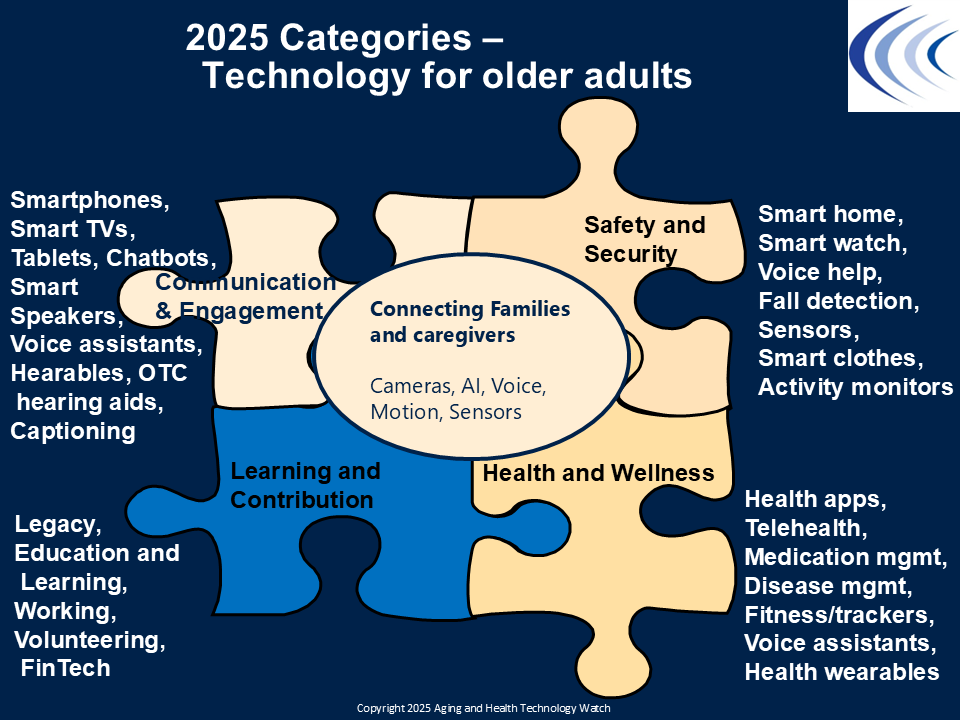 Years ago, tech for older adults became a unique category – is it still? Today most older adults want to use all consumer technology, aka AllTech. Why? Because their families and peers do so, for one, and second, (or maybe first), they do not consider themselves old. A puzzle framework evolved over the years that can encompass ‘AllTech’ but adds supportive tech for those with specific limitations like hearing loss, as well as many other enabling technologies for vision limitations, fall prevention/detection, mobility and transportation needs. The categories of technology have been supercharged as the world of cameras, voice technology, motion sensors, and most recently the addition of machine learning and other AI tools that represent the next generation of utility for older adults. Today, these capabilities are all the more useful -- as life expectancy at 65 extends well into the 80’s for both men and women (see Market Overview Technology for Aging 2025).
Years ago, tech for older adults became a unique category – is it still? Today most older adults want to use all consumer technology, aka AllTech. Why? Because their families and peers do so, for one, and second, (or maybe first), they do not consider themselves old. A puzzle framework evolved over the years that can encompass ‘AllTech’ but adds supportive tech for those with specific limitations like hearing loss, as well as many other enabling technologies for vision limitations, fall prevention/detection, mobility and transportation needs. The categories of technology have been supercharged as the world of cameras, voice technology, motion sensors, and most recently the addition of machine learning and other AI tools that represent the next generation of utility for older adults. Today, these capabilities are all the more useful -- as life expectancy at 65 extends well into the 80’s for both men and women (see Market Overview Technology for Aging 2025).
Why a puzzle? The puzzle paradigm represents the interlocking of four categories that together enable older adults ideally to age successfully, ensuring safety, maintaining health and fitness, and continuing to work, learn, volunteer and manage finances. As tech adoption statistics demonstrate, older adults are increasingly connected, users of broadband in the home, owning smartphones and tablets, going online to help them make decisions, and benefiting from wearables that can help them be more independent and motivated to maintain their wellbeing. At the center of the puzzle, families and caregivers can connect with and participate in their loved ones’ lives and wellbeing. At the same time, professionals that serve older adults also enable access to these capabilities, through creating awareness, training, and support. What are the categories?
Communication and engagement. The technologies in this category are enablers for accessing most of the capabilities in the other categories. Without these, which provide access to the Internet and multiple services needed by people with hearing loss or limited vision, for example, many older adults might struggle to receive useful information. In addition, they would not benefit from engaging with friends, family or local service providers.
Safety and security. So much has changed in technology in recent years. Today’s older adults have a broad range of options to help feel and be safer in their own homes or when out and about. These include smart home capabilities like smart doorbells, voice help, smart watches, fall detection and activity (motion) monitors. These features also help their families be aware of what’s going on in an older person’s home.
Health and wellness. Consider past decade’s emergence of 350,000 health apps, including many that are broadly adopted today by older adults, including telehealth for communicating with health professionals, health wearables and health apps on smartphones, disease management software and many tools to manage medications.
Learning and contribution. Staying engaged in and contributing to the world around them is key to the wellbeing of older adults. For example, at least a quarter of older adults today volunteer, a percentage that has steadily grown along with life expectancy. And at least 20% of the 65+ population are still working. Many take courses to enhance job skills or simply learn something they didn’t know.
The interlocking puzzle pieces for older adults represent the four categories required to age successfully and even thrive as people age into their 80s and beyond. Why do (and should) older adults try new technology today? Probably the biggest driver is a fear of missing out, noticing what others (including family) are doing and wanting to be a part of it. (See below).



 Years ago, tech for older adults became a unique category – is it still? Today most older adults want to use all consumer technology, aka AllTech. Why? Because their families and peers do so, for one, and second, (or maybe first), they do not consider themselves old. A puzzle framework evolved over the years that can encompass ‘AllTech’ but adds supportive tech for those with specific limitations like
Years ago, tech for older adults became a unique category – is it still? Today most older adults want to use all consumer technology, aka AllTech. Why? Because their families and peers do so, for one, and second, (or maybe first), they do not consider themselves old. A puzzle framework evolved over the years that can encompass ‘AllTech’ but adds supportive tech for those with specific limitations like 
